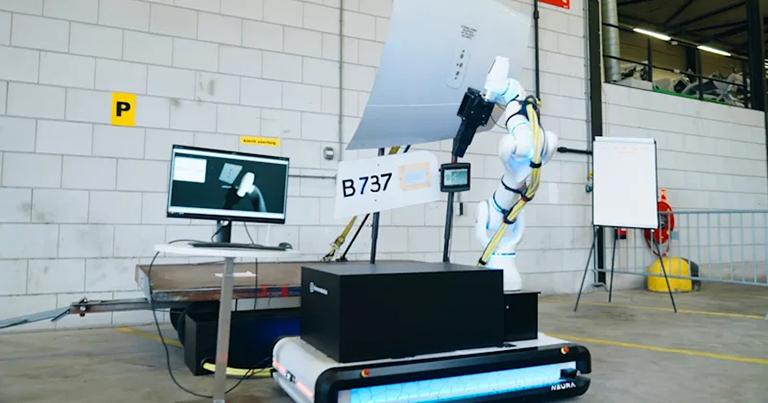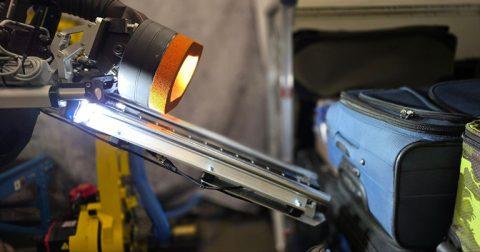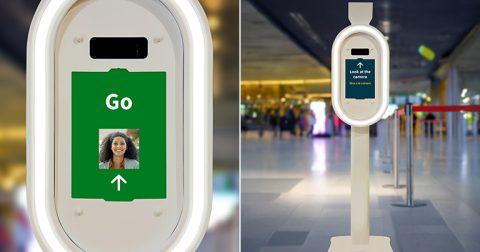
Airports are the beating hearts of global mobility, but behind every smooth arrival and departure lies a complex choreography of ground operations. One critical step is connecting aircraft to ground power units (GPUs) during docking – a process that, until now, has relied on human intervention. At Amsterdam Airport Schiphol (a Corporate Partner of the FTE Digital, Innovation & Startup Hub and a member of the pioneering FTE Smart Ramp program) a bold new chapter is unfolding: the development of ARC (Autonomous Robot for GPU Connection), a technology that could redefine how airports operate, making aviation more efficient, sustainable, and future-proof. The ARC project is a Proof of Concept being undertaken as part of the FTE Smart Ramp initiative, which has the ultimate goal that aircraft turnaround can be achieved autonomously and more efficiently.
The problem: bottlenecks and environmental impact
Connecting an aircraft to ground power is essential for maintaining onboard systems while engines and auxiliary power units (APUs) are shut down. Traditionally, ground handling staff perform this task, but airports worldwide face chronic staff shortages and high physical demands. These challenges can lead to delays, forcing aircraft to idle and burn fuel unnecessarily – resulting in avoidable emissions and reduced operational performance.
The physical strain of manually handling heavy cables and operating access panels also contributes to workforce attrition, compounding the problem. Schiphol’s innovation team recognised that automating this process could not only improve efficiency but also create a healthier work environment and reduce aviation’s environmental footprint. It is also part of the bigger initiative called seamless inbound flow that aims at automating the entire docking power.
The solution: ARC – Autonomous Robot for GPU Connection
A collaborative innovation between Schiphol, KLM and NEURA Robotics, ARC (Autonomous Robot for GPU Connection) is developed with borrowed components of already existing technology to validate the riskiest assumptions, such as:
- Cable handling: picking up and dragging the heavy power cable from its station to the aircraft.
- Navigation: using LiDAR, can the robot navigate on the busy apron, avoiding obstacles and positioning itself precisely at the aircraft’s access panel.
- Panel operation: aircraft access panels are often secured with multiple buttons. ARC’s gripper, equipped with a computer vision system, identifies the correct panel and uses a custom-designed ‘pricker’ with suction technology to press buttons and fully open the panel.
- Connection: ARC then inserts the cable into the socket, completing the connection without human intervention.
This process required overcoming significant technical hurdles. For example, the cable’s position in the robot’s safety zone initially prevented movement. The team solved this by mounting the cable from a height, creating a parabola that kept it outside the safety zone, allowing ARC to move freely while dragging the cable.

Final outcomes: from demo to global collaboration
The recent live demo at Schiphol brought together stakeholders, global partners, airports, airlines, and ground handlers. The response was overwhelmingly positive, validating the business case for scaling up ARC and similar technologies. Schiphol is now looking to further develop this technology.
Call to action: join the innovation journey
Schiphol’s innovation team is inviting global innovators, ecosystem partners, and visionary collaborators to join the next phase of this journey. If you missed the demo, webinars will be held in December 2025 and January 2026 to showcase ARC and discuss further opportunities.
Groundbreaking FTE Smart Ramp program, accelerating automation and collaborative innovation
Smart Ramp is the latest initiative as part of the groundbreaking FTE Accelerating Collaboration & Engagement (ACE) platform launched in partnership with innovation consultancy nlmtd. ACE is dedicated to driving real collaborative action among stakeholders, facilitating fast progress and dynamic change in key areas of the aviation industry which are ripe for transformation. International Airlines Group, Miami International Airport, All Nippon Airways, Royal Schiphol Group, KLM Royal Dutch Airlines, and Metropolitan Washington Airports Authority are all members of what is a truly global collaborative innovation initiative.
The focus on Smart Ramp operations has the ultimate goal that aircraft turnaround can be achieved autonomously and more efficiently. A phased approach will assess which solutions truly work by each member testing new technologies, while incorporating requirements from the other participants. The program will support startups and introduce new suppliers not yet active in aviation, forging paths together on how to overcome hurdles while also exploring the potential for shared investments in the future. Results of the innovations will be shared with respective experts, industry bodies and regulators, meaning the outcomes can be used to create recommended practices and standards in the industry.
Rapid progress has been made since the launch of Smart Ramp and the innovation challenges already planned by members include some 20 projects across eight airports in 2025. These include Schiphol Group and KLM collaborating on autonomous FOD detection and removal for a seamless inbound aircraft flow, reducing wait times, lowering apron emissions, and improving worker health; and autonomously connecting aircraft to 400Hz power to reduce apron emissions and create a healthier work environment for staff.
Learn more about Smart Ramp and the FTE Accelerating Collaboration & Engagement (ACE) platform and how to participate >>








